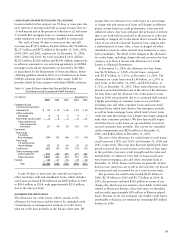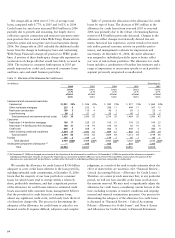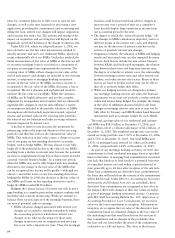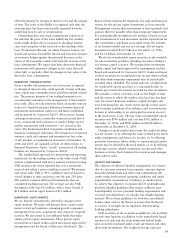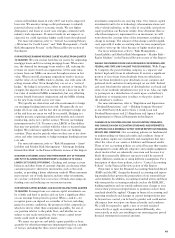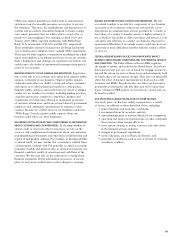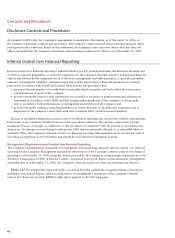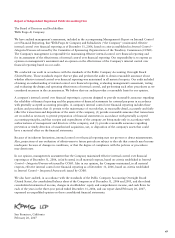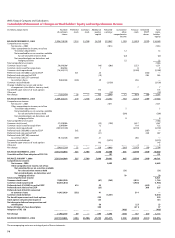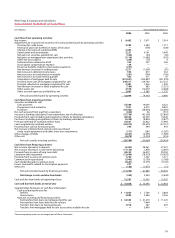Wells Fargo 2006 Annual Report Download - page 64
Download and view the complete annual report
Please find page 64 of the 2006 Wells Fargo annual report below. You can navigate through the pages in the report by either clicking on the pages listed below, or by using the keyword search tool below to find specific information within the annual report.
62
CHANGES IN STOCK MARKET PRICES COULD REDUCE FEE INCOME FROM
OUR BROKERAGE AND ASSET MANAGEMENT BUSINESSES. We earn fee
income from managing assets for others and providing brokerage
services. Because investment management fees are often based on
the value of assets under management, a fall in the market prices
of those assets could reduce our fee income. Changes in stock
market prices could affect the trading activity of investors, reducing
commissions and other fees we earn from our brokerage business.
For more information, refer to “Risk Management – Asset/
Liability and Market Risk Management – Market Risk – Equity
Markets” in the Financial Review section of this Report.
CHANGES IN INTEREST RATES COULD REDUCE OUR NET INTEREST
INCOME AND EARNINGS. Our net interest income is the interest we
earn on loans, debt securities and other assets we hold minus the
interest we pay on our deposits, long-term and short-term debt
and other liabilities. Net interest income reflects both our net
interest margin—the difference between the yield we earn on
our assets and the interest rate we pay for deposits and our
other sources of funding—and the amount of earning assets
we hold. As a result, changes in either our net interest margin
or the amount of earning assets we hold could affect our net
interest income and our earnings.
Changes in interest rates—up or down—could adversely
affect our net interest margin. Although the yield we earn on
our assets and our funding costs tend to move in the same direc-
tion in response to changes in interest rates, one can rise or fall
faster than the other, causing our net interest margin to expand
or contract. Our liabilities tend to be shorter in duration than
our assets, so they may adjust faster in response to changes in
interest rates. As a result, when interest rates rise, our funding
costs may rise faster than the yield we earn on our assets, caus-
ing our net interest margin to contract until the yield catches up.
Changes in the slope of the “yield curve”—or the spread
between short-term and long-term interest rates—could also
reduce our net interest margin. Normally, the yield curve is
upward sloping, meaning short-term rates are lower than long-
term rates. Because our liabilities tend to be shorter in duration
than our assets, when the yield curve flattens or even inverts, we
could experience pressure on our net interest margin as our cost
of funds increases relative to the yield we can earn on our assets.
We assess our interest rate risk by estimating the effect on
our earnings under various scenarios that differ based on
assumptions about the direction, magnitude and speed of inter-
est rate changes and the slope of the yield curve. We hedge some
of that interest rate risk with interest rate derivatives. We also
rely on the “natural hedge” that our loan originations and ser-
vicing rights can provide.
We do not hedge all of our interest rate risk. There is always
the risk that changes in interest rates could reduce our net interest
income and our earnings in material amounts, especially if actual
conditions turn out to be materially different than what we assumed.
For example, if interest rates rise or fall faster than we assumed or
the slope of the yield curve changes, we may incur significant losses
on debt securities we hold as investments. To reduce our interest
rate risk, we may rebalance our investment and loan portfolios,
refinance our debt and take other strategic actions. We may incur
losses or expenses when we take such actions.
For more information, refer to “Risk Management –
Asset/Liability and Market Risk Management – Interest Rate
Risk” in the Financial Review section of this Report.
CHANGES IN INTEREST RATES COULD ALSO REDUCE THE VALUE OF OUR
MORTGAGE SERVICING RIGHTS AND EARNINGS. We have a sizeable
portfolio of mortgage servicing rights. A mortgage servicing right
(MSR) is the right to service a mortgage loan—collect principal,
interest, escrow amounts, etc.—for a fee. We acquire MSRs
when we keep the servicing rights after we sell or securitize the
loans we have originated or when we purchase the servicing
rights to mortgage loans originated by other lenders. We also
acquire MSRs under co-issuer agreements that provide for us to
service loans that are originated and securitized by third-party
correspondents. Effective January 1, 2006, upon adoption of
FAS 156, we elected to initially measure and carry our residential
MSRs using the fair value measurement method. Fair value is the
present value of estimated future net servicing income, calculated
based on a number of variables, including assumptions about
the likelihood of prepayment by borrowers.
Changes in interest rates can affect prepayment assumptions
and thus fair value. When interest rates fall, borrowers are more
likely to prepay their mortgage loans by refinancing them at a
lower rate. As the likelihood of prepayment increases, the fair
value of our MSRs can decrease. Each quarter we evaluate the
fair value of our MSRs, and any decrease in fair value reduces
earnings in the period in which the decrease occurs.
For more information, refer to “Critical Accounting Policies”
and “Risk Management – Asset/Liability and Market Risk
Management – Mortgage Banking Interest Rate Risk” in the
Financial Review section of this Report.
HIGHER CREDIT LOSSES COULD REQUIRE US TO INCREASE OUR
ALLOWANCE FOR CREDIT LOSSES THROUGH A CHARGE TO EARNINGS.
When we loan money or commit to loan money we incur credit
risk, or the risk of losses if our borrowers do not repay their
loans. We reserve for credit losses by establishing an allowance
through a charge to earnings. The amount of this allowance is
based on our assessment of credit losses inherent in our loan
portfolio (including unfunded credit commitments). The process
for determining the amount of the allowance is critical to our
financial results and condition. It requires difficult, subjective
and complex judgments about the future, including forecasts
of economic or market conditions that might impair the ability
of our borrowers to repay their loans.
We might underestimate the credit losses inherent in our
loan portfolio and have credit losses in excess of the amount
reserved. We might increase the allowance because of changing
economic conditions. For example, in a rising interest rate envi-
ronment, borrowers with adjustable rate loans could see their
payments increase. In the absence of offsetting factors such as
increased economic activity and higher wages, this could reduce
their ability to repay their loans, resulting in our increasing the
allowance. We might also increase the allowance because of
unexpected events, as we did in third quarter 2005 for
Hurricane Katrina.
The auto loan portfolio posted losses at elevated levels in the
third and fourth quarters of 2006 partially due to growth and
seasoning, but largely due to collection capacity constraints and
restrictive payment extension practices during Wells Fargo
Financial’s integration of the prime and non-prime auto loan
businesses. We continued to hire and train new collectors and
contract with external collections vendors to increase capacity.
We also adjusted account acquisition strategies to reduce new loan
volumes, particularly in higher-risk tiers. We anticipate these



